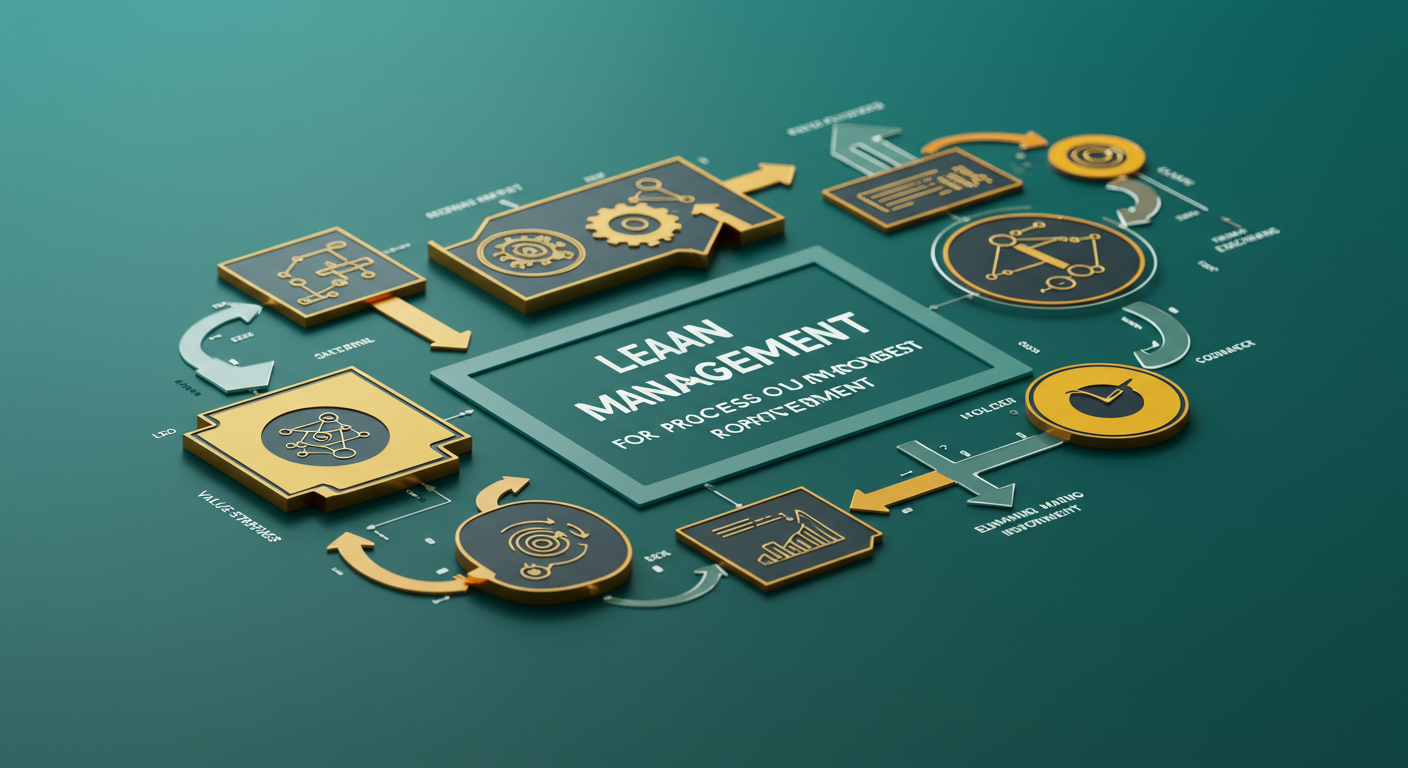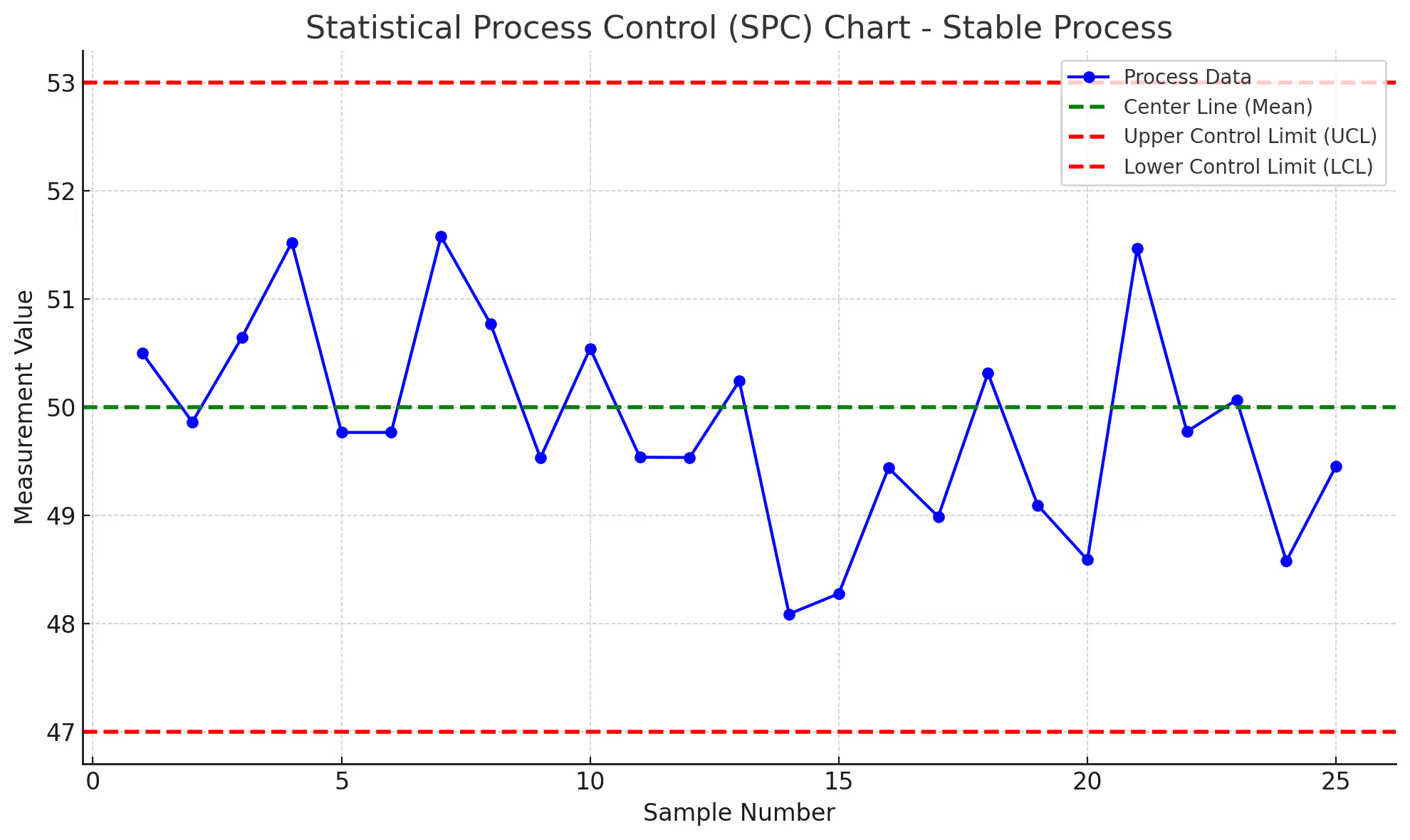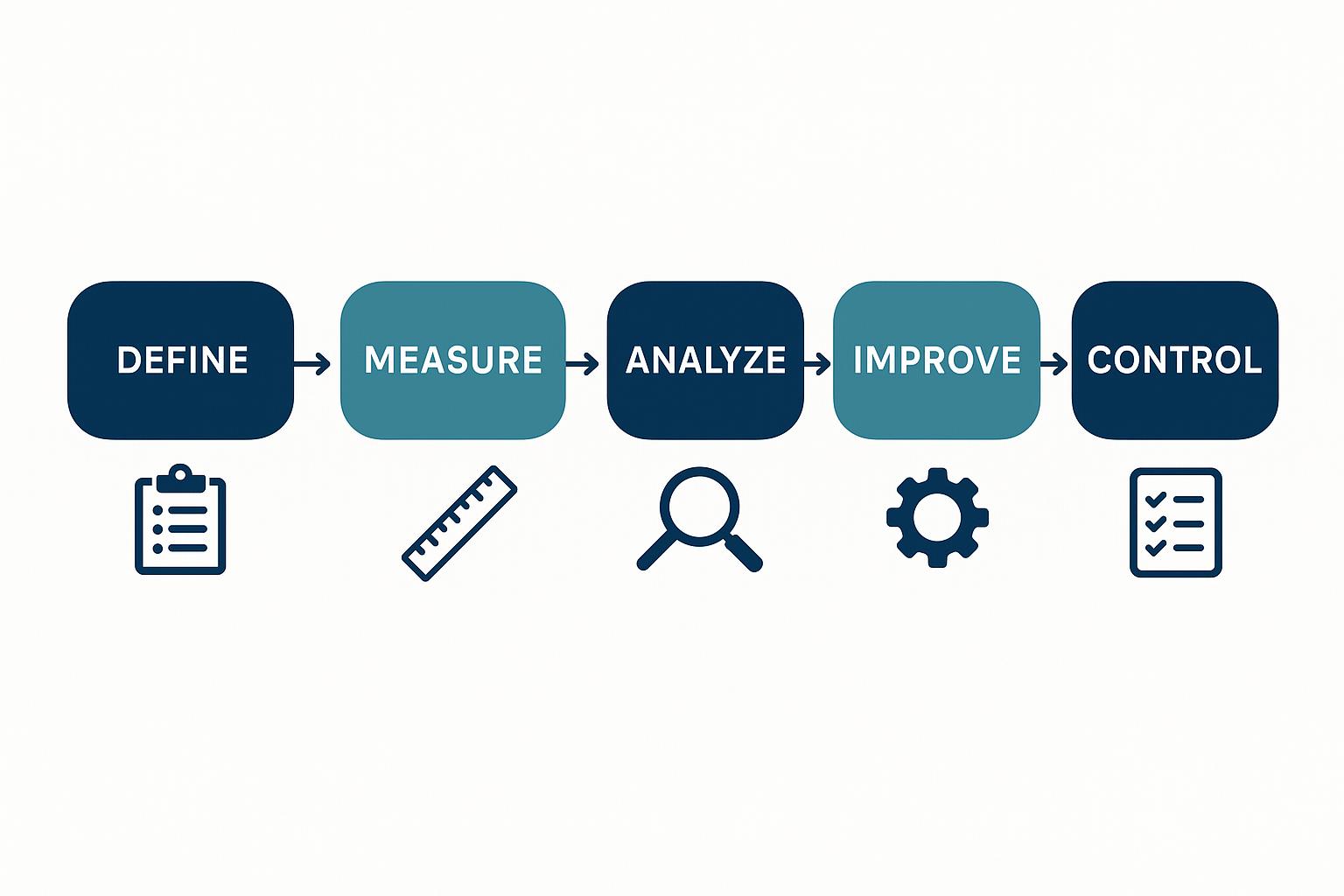🎯 Quick Answer
What: Lean management eliminates waste and optimizes flow through systematic identification and removal of non-value-adding activities.
Why It Matters: Organizations implementing lean management see 15-25% efficiency gains, reduced lead times by 50-90%, and improved quality without complex statistics.
How to Apply: Follow the five lean principles: Define Value, Map Value Stream, Create Flow, Establish Pull, Pursue Perfection.
Expected Results: Most organizations achieve 20-30% cost reduction, 40-60% space reduction, and 50% improvement in delivery times within 12 months.
The Morning Walk That Changes Everything
A plant manager walks the production floor at 6 AM. Every morning. Same route.
She notices workers walking extra steps to retrieve tools. Inventory piling up between stations. Machines sitting idle while operators search for materials.
Six months later, that same walk reveals transformation. Tools within arm's reach. Smooth product flow. Operators focused on value-adding work. Production up 30%. Costs down 25%. No complex statistics required.
The Power of Observation
This transformation didn't require Six Sigma's statistical analysis. It didn't need Black Belts or control charts.
It needed lean management. The systematic elimination of waste through observation, common sense, and disciplined implementation.
Yet most organizations jump straight to Lean Six Sigma, adding statistical complexity before mastering the fundamentals. Like learning calculus before arithmetic.
Building the Foundation
After implementing process improvements worth $4.4 billion across semiconductor manufactuirng, hospital systems, and oil fields, one pattern emerges consistently.
Organizations that master lean management first achieve 3x better results when they add Six Sigma later.
💡 Critical Insight: Lean management isn't just a stepping stone to Six Sigma. For many organizations, it's the complete solution.
Understanding Lean Management
Lean management originated in Japanese manufacturing, specifically the Toyota Production System. But its principles transcend geography and industry.
The core philosophy: maximize customer value while minimizing waste.
Simple concept. Revolutionary impact.
The Fundamental Difference
Lean focuses on flow and waste. Six Sigma focuses on variation and defects.
Both improve processes. But they attack different problems with different tools.
Lean management asks: "Is this step necessary?" Six Sigma asks: "Is this step consistent?"
📊 Reality Check: 60% of process problems stem from waste, not variation. That's why lean management often delivers faster results than Six Sigma.
When Lean Alone Suffices
Pattern recognition across industries reveals when lean management provides complete solutions:
Retail Operations: A Fortune 50 home improvement retailer reduced checkout times 40% using lean principles alone. No statistical analysis needed. Just systematic waste elimination.
Hospital Emergency Departments: Multiple facilities cut patient wait times 50-70% through lean flow improvements. The problem wasn't variation. It was inefficient patient movement.
Manufacturing Assembly: Semiconductor assembly operations improved productivity 35% by eliminating motion waste. Statistical control came later. Flow optimization came first.
The Five Principles of Lean Management
Lean management follows five sequential principles. Each builds on the previous. Skip one, and the system fails.
1. Define Value
Value means what customers actually pay for. Everything else is waste.
The Shocking Reality: Studies across industries show only 5-10% of activities add actual value. The remaining 90-95%? Necessary evils or pure waste.
In healthcare, patients value diagnosis and treatment. Not paperwork. Not waiting. Not redundant tests.
In manufacturing, customers value product features. Not inventory storage. Not inspection. Not rework.
In oil & gas operations, value is safe, efficient extraction. Not permit delays. Not equipment downtime. Not excessive documentation.
⚠️ Common Mistake: Organizations define value from their perspective, not the customer's. This fundamental error undermines everything that follows.
2. Map the Value Stream
Value stream mapping reveals the current state of your process. All of it. The good, bad, and ugly.
What Gets Exposed:
Where value gets created
Where waste accumulates
Where flow stops
Where complexity hides
A regional hospital mapped their surgical instrument sterilization process. The instruments traveled 1.2 miles through the facility. After lean redesign? 300 feet.
A semiconductor manufacturer discovered products spent 95% of production time waiting. Actual processing? 5%. The opportunity became obvious.
3. Create Flow
Once waste is identified, create continuous flow. Products, patients, or information should move smoothly without interruption.
Breaking the Batch Mindset: Traditional thinking says batch processing increases efficiency. Lean thinking proves otherwise.
Consider medical lab testing. Batching samples seems efficient. But it creates waiting. Samples sit until the batch fills. Results wait until the entire batch completes.
Continuous flow processes samples immediately. Results emerge continuously. Turn-around time drops 60-80%.
4. Establish Pull
Pull means producing only what customers demand, when they demand it. Not what forecasts predict. Not what schedules dictate.
Push vs Pull Reality:
Push systems (traditional):
Produce to forecast
Build inventory
Hope demand matches supply
Pull systems (lean):
Produce to actual demand
Minimize inventory
Respond to real consumption
A medical supply company shifted from push to pull. Inventory dropped 40%. Stock-outs disappeared. Cash flow improved dramatically.
5. Pursue Perfection
Perfection seems impossible. That's the point. The pursuit drives continuous improvement.
Each improvement reveals new opportunities. Each solution exposes hidden problems. The cycle never ends.
💡 Field Truth: Organizations that stop improving start declining. Perfection isn't the goal. Continuous pursuit is.
Essential Lean Management Tools
Lean management employs specific tools for specific purposes. Master these five, and 80% of problems become solvable.
5S Methodology
5S creates organized, efficient, safe workplaces. The five S's:
Sort: Remove unnecessary items Set in Order: Organize remaining items Shine: Clean and inspect Standardize: Create consistent practices Sustain: Maintain and improve
Cross-Industry 5S Success
Semiconductor Cleanroom: 5S reduced particle contamination 60%. Not through better filters. Through better organization.
Hospital Operating Room: 5S cut surgical setup time 35%. Instruments organized. Supplies accessible. Efficiency improved.
Oil Platform Maintenance: 5S prevented 40% of safety incidents. Tools secured. Walkways clear. Hazards eliminated.
📊 Universal Pattern: 5S typically delivers 20-30% efficiency improvement regardless of industry.
Kaizen (Continuous Improvement)
Kaizen means "change for better" in Japanese. In practice, it means small, continuous improvements by everyone.
Not massive transformations. Not revolutionary changes. Small steps. Every day. By everyone.
The Compound Effect: 1% daily improvement compounds to 37x improvement annually. Mathematics, not magic.
A medical device manufacturer implemented daily kaizen. Each operator suggested one small improvement monthly. Annual impact? $2.3 million saved. From small ideas.
Value Stream Mapping
Value stream mapping visualizes entire processes from supplier to customer. It reveals:
Cycle times
Wait times
Inventory levels
Information flows
But the real power? It shows waste visually. Problems become obvious. Solutions emerge naturally.
Industry Applications
Healthcare Patient Flow: Maps patient journey from admission to discharge. Reveals bottlenecks in registration, testing, treatment, and discharge.
Manufacturing Production: Tracks products from raw materials to shipping. Exposes inventory accumulation, quality issues, and production delays.
Retail Operations: Follows products from receiving to sale. Identifies storage inefficiencies, stocking delays, and checkout bottlenecks.
Standard Work
Standard work documents the current best practice for any process. Not permanent. Just current best.
It provides:
Consistent quality
Predictable output
Training foundation
Improvement baseline
Without standard work, improvement is impossible. You can't improve chaos.
Visual Management
Visual management makes problems visible instantly. No reports. No meetings. Just look.
Examples across industries:
Color-coded inventory levels
Shadow boards for tools
Patient status boards
Production status displays
Safety performance charts
💡 Key Principle: If you can't see it, you can't manage it. Visual management makes the invisible visible.
Lean Management vs Lean Six Sigma
Understanding when to use lean management alone versus adding Six Sigma prevents over-complication and accelerates results.
When Lean Management Alone Works
High Waste, Low Variation: When problems stem from inefficiency, not inconsistency, lean management suffices.
Speed Matters More Than Precision: When 80% improvement in three months beats 95% improvement in 18 months.
Cultural Readiness: When organizations aren't ready for statistical thinking but can embrace waste elimination.
Real Decision Framework
Ask these questions:
Is the problem visible? ✅ Yes → Start with lean management ❌ No → Consider Six Sigma
Is the solution obvious once problems are mapped? ✅ Yes → Lean management ❌ No → Add Six Sigma analysis
Does the process need control or improvement? ✅ Improvement → Lean management ❌ Control → Six Sigma required
The Integration Path
Most organizations follow this progression:
Year 1: Lean management basics (5S, visual management) Year 2: Advanced lean tools (value stream mapping, pull systems) Year 3: Add Six Sigma for variation problems Year 4+: Full Lean Six Sigma integration
📊 Success Pattern: Organizations that master lean first achieve 50% better Lean Six Sigma results than those attempting both simultaneously.
Implementation Across Industries
Lean management adapts to any environment where processes exist. The principles remain constant. Applications vary dramatically.
Healthcare Lean Management
Healthcare presents unique challenges:
Life-or-death consequences
High variation in patient needs
Regulatory requirements
Professional autonomy
Yet lean management thrives here.
Emergency Department Flow: Triage → Registration → Treatment → Discharge
Lean improvements:
Bedside registration (eliminate transport waste)
Parallel processing (reduce waiting)
Discharge planning from admission (prevent delays)
Results: 50% reduction in length of stay. Same staff. Same space. Better flow.
Manufacturing Lean Management
Manufacturing birthed lean management. Applications continue evolving.
Semiconductor Manufacturing:
Reduce cleanroom traffic (motion waste)
Optimize equipment utilization (waiting waste)
Minimize work-in-process (inventory waste)
Eliminate redundant inspections (overprocessing waste)
One fab reduced cycle time 40% through lean management alone. Yield improvements came later through Six Sigma.
Retail and Service Lean Management
Service industries initially resisted lean management. "We're not manufacturing."
The principles proved universal.
Retail Operations:
Store layout optimization (motion reduction)
Inventory management (waste reduction)
Checkout process flow (wait reduction)
Staff scheduling (resource optimization)
A major retailer improved customer satisfaction 30% while reducing labor costs 15%. Pure lean management.
Oil & Gas Lean Management
High-risk environments benefit enormously from lean principles.
Offshore Platform Operations:
Permit-to-work simplification (overprocessing)
Tool and equipment organization (5S)
Maintenance scheduling (waiting waste)
Crew change optimization (motion waste)
Results include 25% maintenance efficiency improvement and 40% reduction in safety incidents.
Common Implementation Pitfalls
Learning from failure patterns across hundreds of implementations prevents repeated mistakes.
Pitfall 1: Tool Obsession Without Purpose
Organizations implement 5S because it's a lean tool. Not because it solves specific problems.
Tools serve purposes. Without clear purpose, tools become busy work.
⚠️ Reality Check: Pretty organized workspaces that don't improve performance aren't lean. They're just pretty.
Pitfall 2: Copying Without Adapting
A hospital copies a manufacturing plant's lean approach verbatim. It fails spectacularly.
Principles transfer. Implementations don't.
Patient flow differs from product flow. Adapt accordingly.
Pitfall 3: Leadership Delegation
Executives delegate lean management to middle management. "Make it happen."
Without leadership participation, lean becomes another program. Not a culture.
Leaders must walk the gemba (workplace). See waste firsthand. Champion improvements personally.
Pitfall 4: Improvement Without Standardization
Teams improve processes but don't standardize new methods. Old habits return. Improvements evaporate.
Standardization isn't bureaucracy. It's sustainability.
Pitfall 5: Perfection Paralysis
Organizations delay implementation seeking perfect plans. Meanwhile, waste continues.
70% solutions implemented beat 100% solutions planned. Start small. Improve continuously.
Measuring Lean Success
Lean management requires different metrics than traditional management.
Traditional Metrics (Often Misleading)
Machine utilization (encourages overproduction)
Individual productivity (ignores system performance)
Cost per unit (may hide waste)
Lean Metrics (True Performance)
Lead Time: Total time from order to delivery. Captures entire system performance.
First Pass Yield: Percentage completed correctly first time. No rework. No inspection.
Inventory Turns: How often inventory completely cycles. Higher turns indicate better flow.
Value-Added Ratio: Value-added time ÷ Total lead time. Typically starts at 5%. Goal: exceed 25%.
Overall Equipment Effectiveness (OEE): Availability × Performance × Quality. Reveals true capacity utilization.
📊 Benchmark Reality: World-class lean organizations achieve 50% value-added ratio. Most start below 10%.
The ROI of Lean Management
Lean management delivers returns faster than most improvement methodologies.
Typical Timeline
Month 1-3: Quick wins through 5S and waste identification (5-10% improvement)
Month 4-6: Flow improvements and pull implementation (15-25% improvement)
Month 7-12: Standardization and culture shift (25-35% total improvement)
Year 2+: Continuous improvement momentum (40-50% cumulative gains)
Cost-Benefit Analysis
Investment Required:
Training: $500-1,000 per person
Implementation time: 10-20% of staff hours
External support: Optional but helpful
Typical Returns:
Productivity: 25-35% improvement
Quality: 30-50% defect reduction
Space: 35-50% reduction
Inventory: 40-60% reduction
Lead time: 50-70% reduction
💡 Financial Impact: Every dollar invested in proper lean management returns $10-15 within 18 months.
Building Your Lean Management System
Starting lean management requires strategy, not just enthusiasm.
Phase 1: Foundation (Months 1-3)
Select Pilot Area: Choose bounded, visible, important area. Not the worst. Not the best. Something representative.
Implement 5S: Create visual order. Make problems visible. Build participation habits.
Establish Metrics: Measure current state. Not for judgment. For improvement baseline.
Phase 2: Expansion (Months 4-6)
Value Stream Mapping: Map current state. Identify waste. Design future state.
Create Flow: Eliminate bottlenecks. Reduce batch sizes. Synchronize operations.
Implement Pull: Connect customer demand to production. Reduce inventory. Improve response.
Phase 3: Standardization (Months 7-12)
Document Standard Work: Capture best practices. Train consistently. Enable improvement.
Spread Success: Replicate pilot achievements. Share lessons learned. Build momentum.
Develop Culture: Celebrate improvements. Recognize contributions. Embed lean thinking.
Phase 4: Maturation (Year 2+)
Advanced Tools: Add sophisticated techniques. Consider Six Sigma integration. Tackle complex problems.
Supplier Integration: Extend lean upstream. Synchronize supply chain. Reduce system waste.
Innovation Platform: Use efficiency gains for innovation. Reinvest savings. Accelerate growth.
The Bottom Line
Lean management transforms organizations by eliminating waste and creating flow. No statistical complexity required. Just disciplined observation and systematic improvement.
The $4.4 billion in process improvements across 35+ years reveals consistent truth. Organizations mastering lean management first achieve superior results when adding advanced methodologies later.
Lean management isn't just preparation for Six Sigma. For many organizations, it's the complete solution. The waste elimination and flow optimization solve 60-70% of operational problems.
Start with lean management when:
Problems are visible
Waste exceeds variation
Speed matters more than precision
Organization needs cultural foundation
Add Six Sigma when:
Problems hide in data
Variation drives defects
Precision becomes critical
Control mechanisms are required
The path forward is clear. Walk your operation. See the waste. Apply lean principles. Create flow. Establish pull. Pursue perfection.
Simple concepts. Profound results. That's lean management.
Frequently Asked Questions
What's the difference between lean and lean management?
Lean and lean management are essentially the same concept. "Lean" originated as lean manufacturing in Toyota's production system. "Lean management" encompasses the broader application beyond manufacturing into healthcare, services, and other industries. The principles remain identical: eliminate waste, create flow, and deliver value.
How long does it take to implement lean management?
Basic lean management implementation takes 6-12 months for initial results. Quick wins appear within 30 days through 5S and waste identification. Significant improvements emerge by month six. Cultural transformation requires 2-3 years. However, improvement continues indefinitely as lean management is a continuous journey, not a destination.
Can lean management work without Six Sigma?
Absolutely. Lean management works independently and solves 60-70% of operational problems without statistical analysis. Many organizations successfully use only lean management. Six Sigma adds value when problems involve variation, require statistical control, or hide in data. Think of Six Sigma as an advanced tool set, not a requirement.
What industries benefit most from lean management?
Every industry with processes benefits from lean management. Manufacturing pioneered it. Healthcare achieves remarkable patient flow improvements. Retail optimizes inventory and customer experience. Financial services streamline transactions. Government reduces bureaucracy. Success depends on implementation quality, not industry type. The principles are truly universal.
What's the minimum organization size for lean management?
No minimum exists. Single-person operations benefit from lean principles. Small businesses often see dramatic improvements because waste elimination has immediate impact. Large organizations achieve massive scale benefits. The key isn't size but commitment to continuous improvement and waste elimination. Even personal productivity improves with lean thinking.
Eliminate waste. Create flow. Deliver value.
That's the power of lean management. Start today.
Ready to Start Your Lean Journey?
🎓 Master the fundamentals: Read our comprehensive guide: "What is Lean Six Sigma? The $4.4 Billion Field Reality"
Related Reading:
External Resources:
Lean Enterprise Institute - Original lean thinking resources and research
Toyota Production System - Source of lean manufacturing principles
ASQ Lean Resources - American Society for Quality lean tools and certification
Keywords:
lean management, lean management tools, lean management principles, lean manufacturing, 5S methodology, kaizen, value stream mapping, waste elimination, continuous improvement, just in time, lean vs six sigma, process improvement, operational efficiency, value creation, pull system, visual management, standard work, lean implementation, waste reduction, process flow, lean metrics, lean transformation, gemba walk, lean culture, lean thinking









